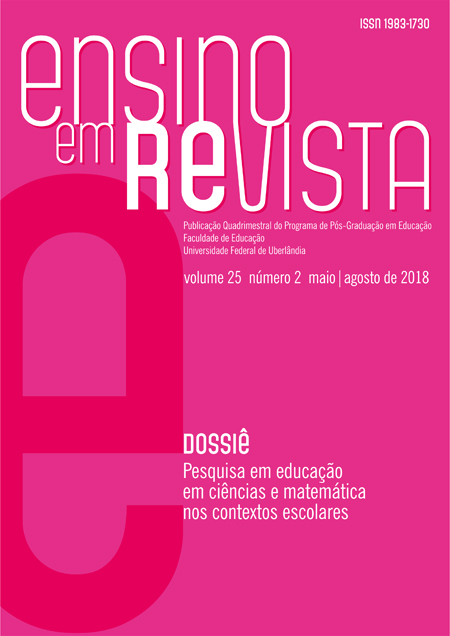Conceptions of physics students about the relationship art and physics
Main Article Content
Abstract
Considering the recognized role of art throughout history as an influence element in the production of scientific knowledge, this exploratory study sought to raise ideas that students of Physics in UFGD have on the relationship between art and physics. Thecutout for the physical lies in the mechanics. To survey concepts that students have about the relationship between physics and art was used an online questionnaire with open and closed questions about art and physics, focusing on perception of the respondent, aspects of the historical relationship between the two and reflections on the construction of scientific knowledge. Analysis of the responses indicated a trend towards acceptance of art as an element able to contribute to the teaching of physics.
Article Details
Section
The published works are the property of their authors, who may make use of them for subsequent publications, always including the original edition (original title, Ensino em Re-Vista, volume, number, pages). All articles in this journal are the sole responsibility of their authors, and no legal responsibility for their content rests with the Journal or EDUFU.
How to Cite
References
ALBERGARIA, D. Quando a ficção inspira a ciência. Ciência e Cultura, v. 62, n. 2, p. 38-44, 2010.
BANDARA, W. et al. Achieving Rigour in Literature Reviews: Insights from Qualitative Data Analysis and Tool-support. Communications of the Association for Information Systems,v. 34, n. 1, p. 154-208, 2015.
BARBOSA, P. Metamorfoses do real: arte, imaginário e conhecimento estético. Porto: Edições Afrontamento, 1995.
BRAGA, M. A. B.; MEDINA, M. N. O teatro como ferramenta de aprendizagem da física e de problematização da natureza da ciência. Caderno Brasileiro de Ensino de Física,v. 27, n. 2, p. 313-333, 2010.
ECO, U. Obra aberta: forma e indeterminação nas poéticas contemporâneas. São Paulo: Perspectiva, 1991.
FÁTIMA VESTENA, R. DE; PRETTO, V. O Teatro no ensino de ciências: uma alternativa metodológica na formação docente para os anos iniciais. Vidya, v. 32, n. 2, p. 12, 2012.
FERREIRA, J. C. D.; ALMEIDA RABONI, P. C. DE. A ficção científica de Júlio Verne e o ensino de Física: uma análise de “Vinte Mil Léguas Submarinas. Caderno Brasileiro de Ensino de Física, v. 30, n. 1, p. 84-103, 2013.
FLICK, U.; NETZ, S. Uma introdução à pesquisa qualitativa. Porto Alegre: Bookman Porto Alegre, 2009. v. 2.
FONSECA, S. S. N. Teatro científico: uma metodologia para o ensino de física. Aracaju: Universidade Federal de Sergipe, ago. 2014.
GOLDFARB, J. L. Voar também é com os homens: o pensamento de Mário Schenberg. São Paulo: Edusp, 1994.
GOMES-MALUF, M. C.; SOUZA, A. R. DE. A ficção científica e o ensino de ciências: o imaginário como formador do real e do racional. Ciência & Educação, v. 14, n. 2, p. 271-282, 2008.
LAGE, M. Os softwares tipo CAQDAS e a sua contribuição para a pesquisa qualitativa em educação. ETD –Educação Temática Digital, v. 12, n. 2, p. 42-58, 2011.
LIMA, M. C. B.; BARROS, H. L. DE; TERRAZZAN, E. A. Quando o sujeito se torna pessoa: uma articulação possível entre Poesia e ensino de Física. Ciência & Educação, v. 10, n. 2, p. 291-305, 2004.
LUDKE, M.; ANDRÉ, M. E. D. A. Pesquisa em educação - abordagens qualitativas. São Paulo: EPU, 2015.
MORAES, R. Uma tempestade de luz: a compreensão possibilitada pela análise textual discursiva. Ciência & Educação, v. 9, n. 2, p. 191-211, 2003.
MORAES, R.; CARMO GALIAZZI, M. DO. Análise textual discursiva: processo reconstrutivo de múltiplas faces. Ciência & Educação, v. 12, n. 1, p. 117-128, 2006.
MOREIRA, I. DE C. Poesia na sala de aula de ciências? A literatura poética e possíveis usos didáticos. Física na escola, v. 3, n. 1, p. 17-23, 2002.
MOREIRA, L. M.; MARANDINO, M. Teatro de temática científica: conceituação, conflitos, papel pedagógico e contexto brasileiro. Ciência & Educação, v. 21, n. 2, p. 511-523, 2015.
OLIVEIRA, M. M. DE. Como fazer pesquisa qualitativa. Rio de Janeiro: Vozes, 2007.
PÉREZ, D. G. et al. Para uma imagem não deformada do trabalho científico. Ciência & Educação, v. 7, n. 2, p. 125-153, 2001.
REIS, J. C.; GUERRA, A.; BRAGA, M. Física e arte: a construção do mundo com tintas, palavras e equações. Ciência e Cultura, v. 57, n. 3, p. 29-32, 2005.
RODARI, G. Gramática da fantasia. São Paulo: Summus, 2000. SAGAN, C.; GARSCHAGEN, D. M. Contato. São Paulo: Companhia das Letras, 1999.
SNOW, C. P. As Duas Culturas e Uma Segunda Leitura. São Paulo: Edusp, 1995.
SUPPIA, A. L. P. DE O. A divulgação cientifica contida nos filmes de ficção. Ciência e Cultura, v. 58, n. 1, p. 56-58, 2006.
TRIVIÑOS, A. N. S. Introdução à pesquisa em ciências sociais: a pesquisa qualitativa em educação: o positivismo, a fenomenologia, o marxismo. São Paulo: Atlas, 1987.
ZANETIC, J. Física também é cultura. Tese (Doutorado em Educação) –São Paulo: Universidade de São Paulo, 1989.
ZANETIC, J. Física e cultura. Ciência e Cultura, v. 57, n. 3, p. 21-24, 2005.

